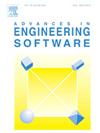IF 4
2区 工程技术
Q2 COMPUTER SCIENCE, INTERDISCIPLINARY APPLICATIONS
引用次数: 0
摘要
本文采用增强型局部损伤模型来描述准脆性材料中裂纹的产生和扩展。该模型使用 ABAQUS 用户子程序平台 UMAT 实现,适用于二维和三维介质的断裂。与往常一样,材料状态由损伤参数 D 表示,范围从 0(完好无损)到 1(完全破坏)。与传统的局部损伤模型(Kachanov [1], 1999)和(Lemaitre [2], 1985)不同的是,在计算损伤参数时将断裂能和元素的特征长度都考虑在内,因此减轻了固有的网格依赖问题。我们对混合模式条件下等效应变对裂纹路径预测以及荷载-位移曲线的影响进行了比较研究。为此,基于三种模型采用了三种等效应变:改进的 von Mises 模型、Ottosen 准则模型和新的 Mazars 模型(本文以 Mazars 等人的研究成果命名,[3] (2015))。通过将计算结果与实验数据以及文献中报道的其他数值结果进行比较,证明了所开发的代码和所提出的损伤方法与三种等效应变相关联的准确性和性能。模拟结果很好地拟合了实验数据。此外,还提供了 UMAT 子程序实施的详细说明。源代码免费提供,用户可根据自己的需要进行修改。本文章由计算机程序翻译,如有差异,请以英文原文为准。
An enhanced local damage model for 2D and 3D quasi-brittle fracture: ABAQUS-FEM implementation and comparative study on the effect of equivalent strains
In this paper, the initiation and propagation of cracks in quasi-brittle materials are characterized by an enhanced local damage model. The model is implemented using UMAT, an ABAQUS user-subroutine platform, for fracture in two- and three-dimensional media. As usual, the material state is represented by a damage parameter ranging from 0 (intact) to 1 (completed failure). Different from the conventional local damage models (Kachanov [1], 1999), (Lemaitre [2], 1985) both fracture energy and characteristic length of the element are incorporated into the calculation of the damage parameter, hence the inherent issue of mesh-dependency is mitigated. A comparative study on the effect of equivalent strain on the prediction of crack path as well as load–displacement curve under mixed-mode condition is conducted. For that purpose, three types of equivalent strain are adopted based on three models: the modified von Mises model, the Ottosen criterion model, and the new Mazars model (named after the work of Mazars et al., [3] (2015) in this paper). The accuracy and performance of the developed codes and proposed damage approach in association with the three types of equivalent strain are demonstrated by comparison of the computed results with experimental data as well as other numerical results reported in the literature. The experimental data is well-fit by the simulation results. A detailed description of implementation in UMAT subroutine is also provided. The source codes are provided for free, and users can amend them for their own purpose.
求助全文
通过发布文献求助,成功后即可免费获取论文全文。
去求助
来源期刊

Advances in Engineering Software
工程技术-计算机:跨学科应用
CiteScore
7.70
自引率
4.20%
发文量
169
审稿时长
37 days
期刊介绍:
The objective of this journal is to communicate recent and projected advances in computer-based engineering techniques. The fields covered include mechanical, aerospace, civil and environmental engineering, with an emphasis on research and development leading to practical problem-solving.
The scope of the journal includes:
• Innovative computational strategies and numerical algorithms for large-scale engineering problems
• Analysis and simulation techniques and systems
• Model and mesh generation
• Control of the accuracy, stability and efficiency of computational process
• Exploitation of new computing environments (eg distributed hetergeneous and collaborative computing)
• Advanced visualization techniques, virtual environments and prototyping
• Applications of AI, knowledge-based systems, computational intelligence, including fuzzy logic, neural networks and evolutionary computations
• Application of object-oriented technology to engineering problems
• Intelligent human computer interfaces
• Design automation, multidisciplinary design and optimization
• CAD, CAE and integrated process and product development systems
• Quality and reliability.
 求助内容:
求助内容: 应助结果提醒方式:
应助结果提醒方式:


